Big Data Analytics Research Proposal: Challenges and Proposed Methods
VerifiedAdded on 2023/05/30
|8
|1271
|306
Report
AI Summary
This research proposal addresses the challenges and potential solutions in big data analytics. It begins by outlining the problem statement, focusing on issues such as data management uncertainty, the big data talent gap, and synchronization across data sources. The literature review highlights the advantages of big data analytics, including improved marketing, customer service, and operational efficiency. Existing methods like YARN and MapReduce are discussed, along with their limitations. The proposal suggests using Spark and HBase as potential solutions, emphasizing their ability to handle large-scale data analytics applications. The document also touches on validation and comparison examples, stressing the importance of proper data collection and analysis. Overall, the proposal aims to provide a framework for researching and implementing effective big data analytics strategies.
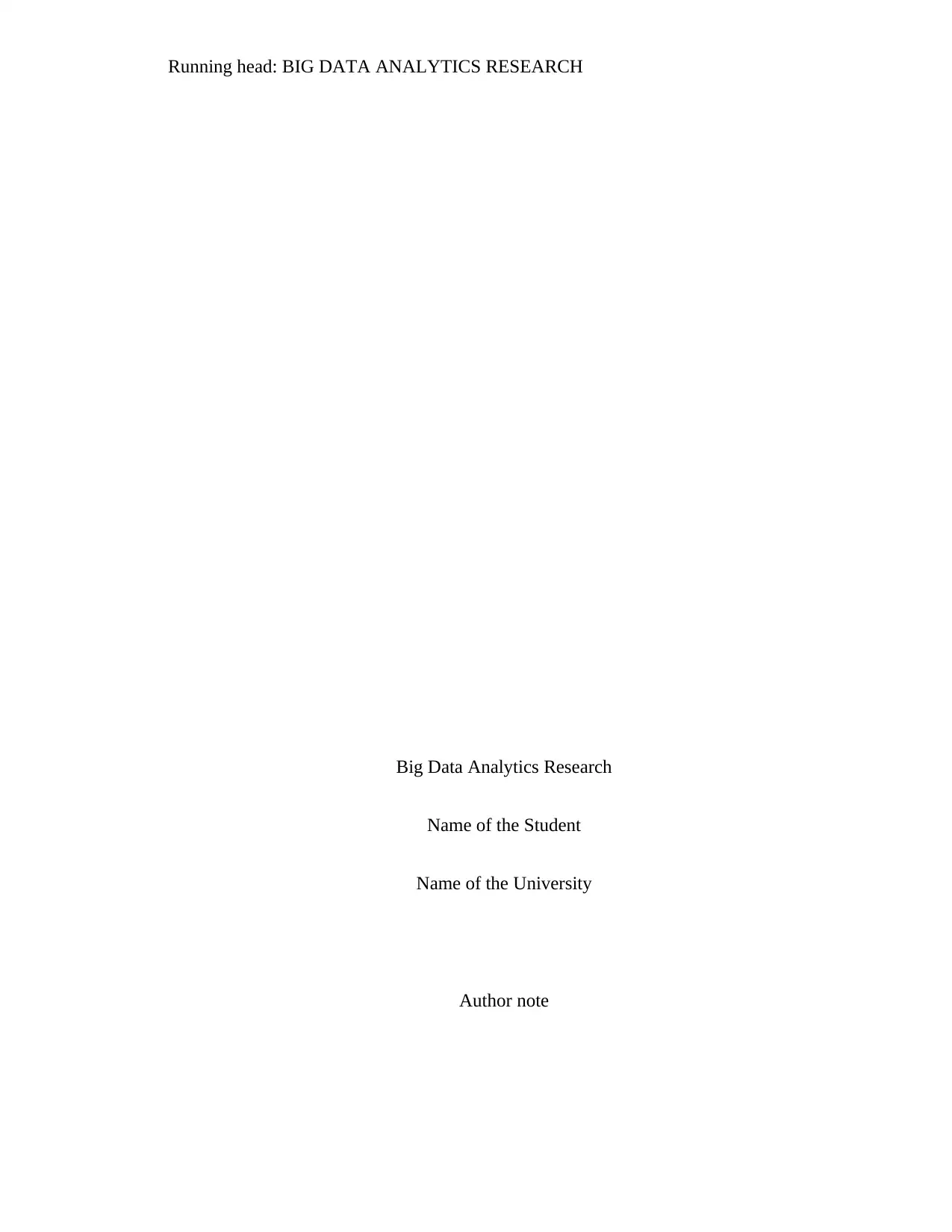
Running head: BIG DATA ANALYTICS RESEARCH
Big Data Analytics Research
Name of the Student
Name of the University
Author note
Big Data Analytics Research
Name of the Student
Name of the University
Author note
Paraphrase This Document
Need a fresh take? Get an instant paraphrase of this document with our AI Paraphraser
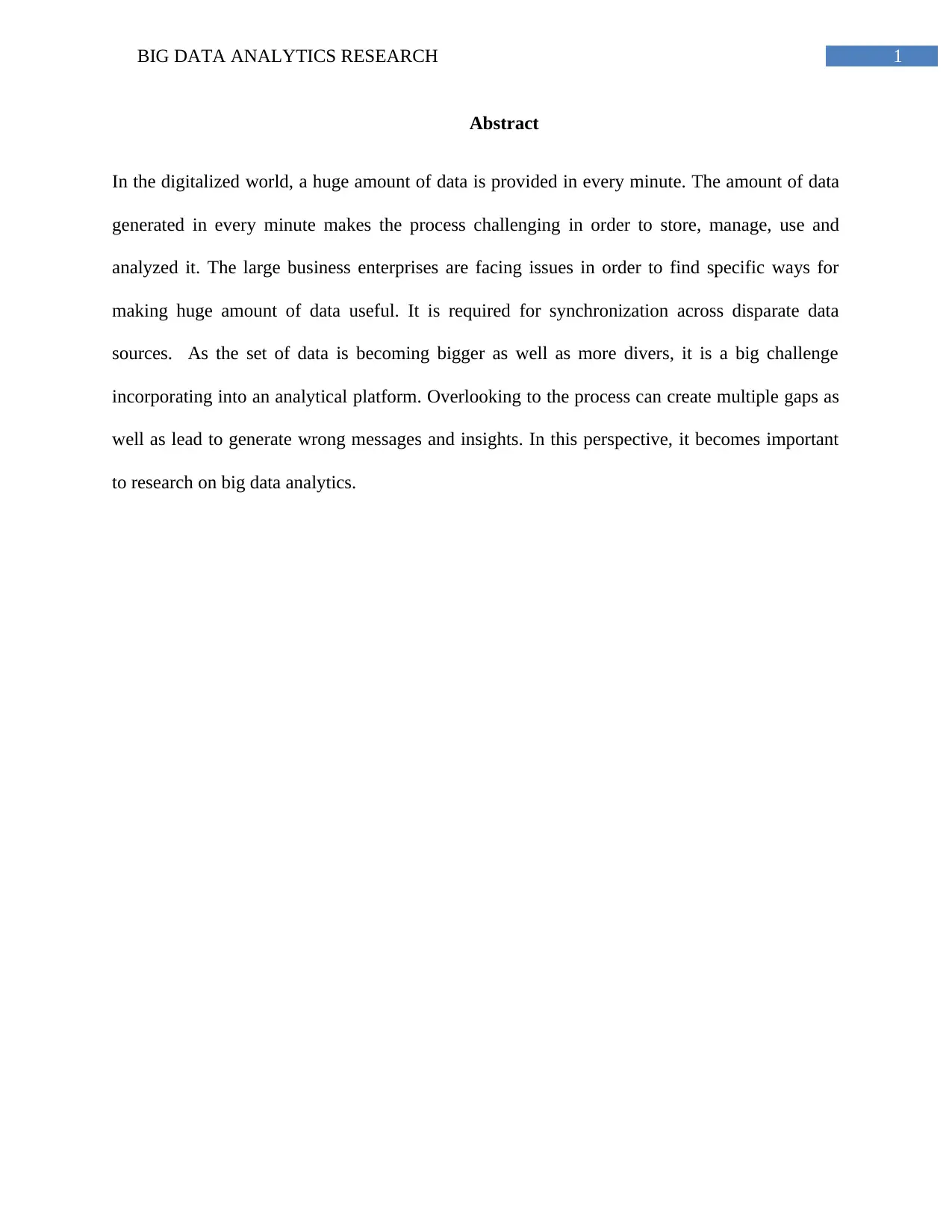
1BIG DATA ANALYTICS RESEARCH
Abstract
In the digitalized world, a huge amount of data is provided in every minute. The amount of data
generated in every minute makes the process challenging in order to store, manage, use and
analyzed it. The large business enterprises are facing issues in order to find specific ways for
making huge amount of data useful. It is required for synchronization across disparate data
sources. As the set of data is becoming bigger as well as more divers, it is a big challenge
incorporating into an analytical platform. Overlooking to the process can create multiple gaps as
well as lead to generate wrong messages and insights. In this perspective, it becomes important
to research on big data analytics.
Abstract
In the digitalized world, a huge amount of data is provided in every minute. The amount of data
generated in every minute makes the process challenging in order to store, manage, use and
analyzed it. The large business enterprises are facing issues in order to find specific ways for
making huge amount of data useful. It is required for synchronization across disparate data
sources. As the set of data is becoming bigger as well as more divers, it is a big challenge
incorporating into an analytical platform. Overlooking to the process can create multiple gaps as
well as lead to generate wrong messages and insights. In this perspective, it becomes important
to research on big data analytics.
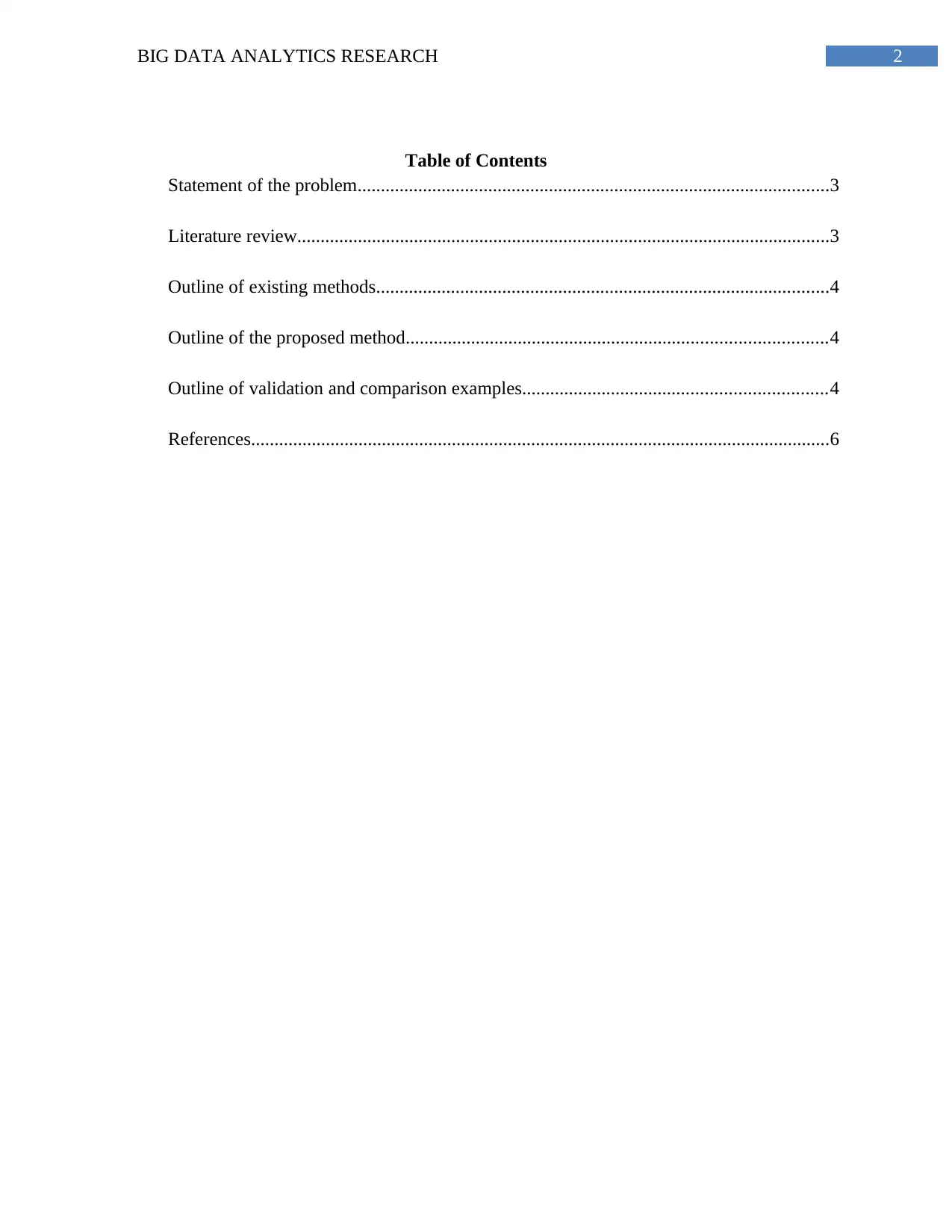
2BIG DATA ANALYTICS RESEARCH
Table of Contents
Statement of the problem.....................................................................................................3
Literature review..................................................................................................................3
Outline of existing methods.................................................................................................4
Outline of the proposed method..........................................................................................4
Outline of validation and comparison examples.................................................................4
References............................................................................................................................6
Table of Contents
Statement of the problem.....................................................................................................3
Literature review..................................................................................................................3
Outline of existing methods.................................................................................................4
Outline of the proposed method..........................................................................................4
Outline of validation and comparison examples.................................................................4
References............................................................................................................................6
⊘ This is a preview!⊘
Do you want full access?
Subscribe today to unlock all pages.

Trusted by 1+ million students worldwide
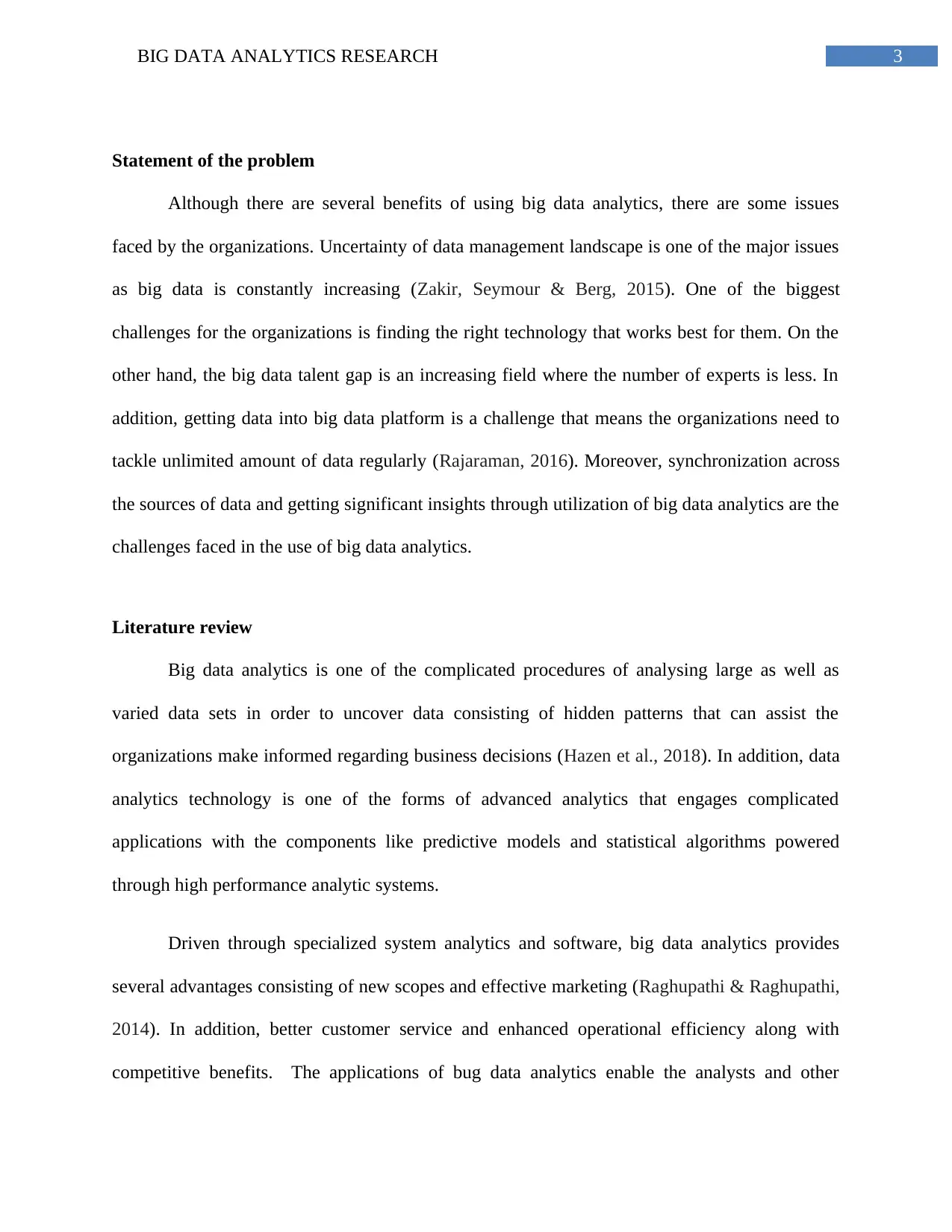
3BIG DATA ANALYTICS RESEARCH
Statement of the problem
Although there are several benefits of using big data analytics, there are some issues
faced by the organizations. Uncertainty of data management landscape is one of the major issues
as big data is constantly increasing (Zakir, Seymour & Berg, 2015). One of the biggest
challenges for the organizations is finding the right technology that works best for them. On the
other hand, the big data talent gap is an increasing field where the number of experts is less. In
addition, getting data into big data platform is a challenge that means the organizations need to
tackle unlimited amount of data regularly (Rajaraman, 2016). Moreover, synchronization across
the sources of data and getting significant insights through utilization of big data analytics are the
challenges faced in the use of big data analytics.
Literature review
Big data analytics is one of the complicated procedures of analysing large as well as
varied data sets in order to uncover data consisting of hidden patterns that can assist the
organizations make informed regarding business decisions (Hazen et al., 2018). In addition, data
analytics technology is one of the forms of advanced analytics that engages complicated
applications with the components like predictive models and statistical algorithms powered
through high performance analytic systems.
Driven through specialized system analytics and software, big data analytics provides
several advantages consisting of new scopes and effective marketing (Raghupathi & Raghupathi,
2014). In addition, better customer service and enhanced operational efficiency along with
competitive benefits. The applications of bug data analytics enable the analysts and other
Statement of the problem
Although there are several benefits of using big data analytics, there are some issues
faced by the organizations. Uncertainty of data management landscape is one of the major issues
as big data is constantly increasing (Zakir, Seymour & Berg, 2015). One of the biggest
challenges for the organizations is finding the right technology that works best for them. On the
other hand, the big data talent gap is an increasing field where the number of experts is less. In
addition, getting data into big data platform is a challenge that means the organizations need to
tackle unlimited amount of data regularly (Rajaraman, 2016). Moreover, synchronization across
the sources of data and getting significant insights through utilization of big data analytics are the
challenges faced in the use of big data analytics.
Literature review
Big data analytics is one of the complicated procedures of analysing large as well as
varied data sets in order to uncover data consisting of hidden patterns that can assist the
organizations make informed regarding business decisions (Hazen et al., 2018). In addition, data
analytics technology is one of the forms of advanced analytics that engages complicated
applications with the components like predictive models and statistical algorithms powered
through high performance analytic systems.
Driven through specialized system analytics and software, big data analytics provides
several advantages consisting of new scopes and effective marketing (Raghupathi & Raghupathi,
2014). In addition, better customer service and enhanced operational efficiency along with
competitive benefits. The applications of bug data analytics enable the analysts and other
Paraphrase This Document
Need a fresh take? Get an instant paraphrase of this document with our AI Paraphraser
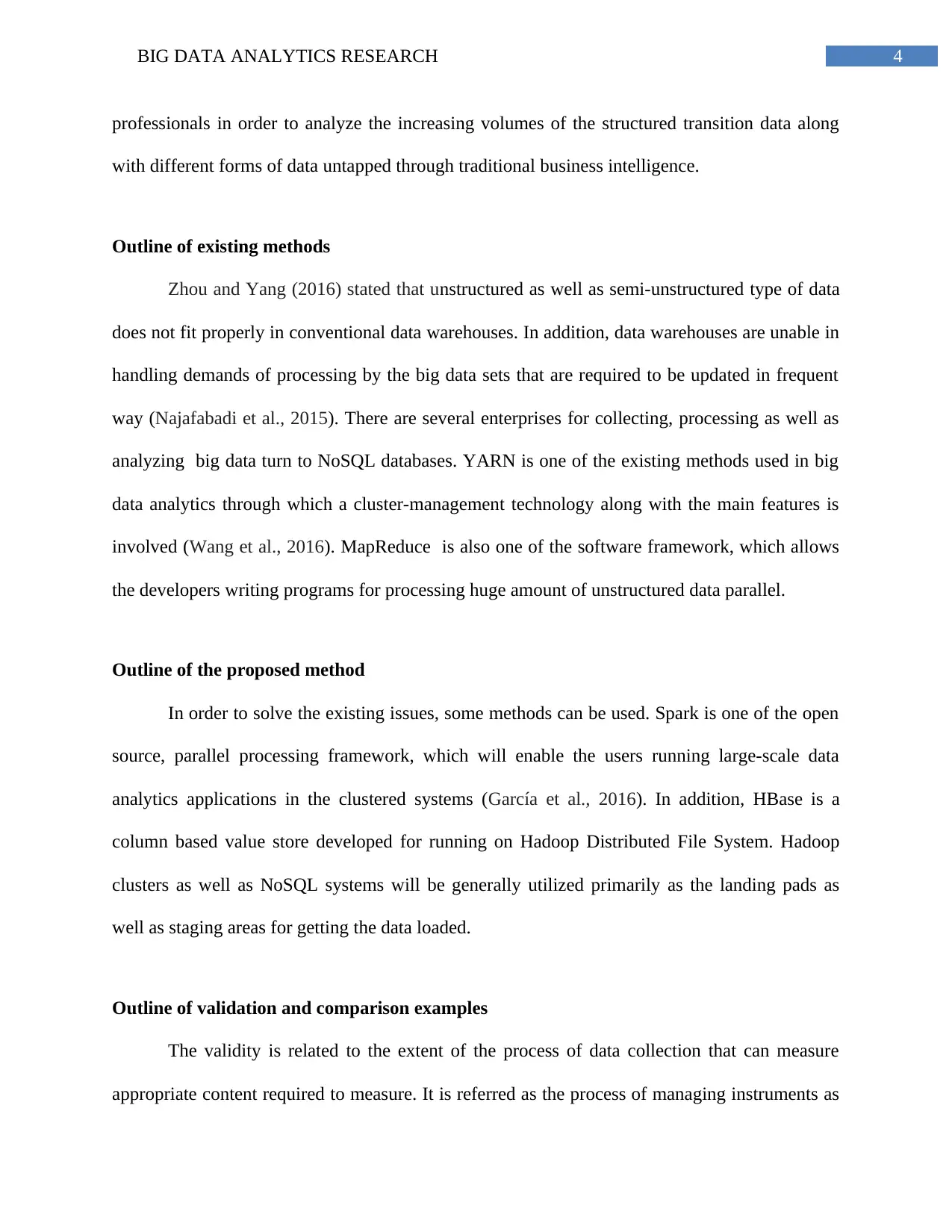
4BIG DATA ANALYTICS RESEARCH
professionals in order to analyze the increasing volumes of the structured transition data along
with different forms of data untapped through traditional business intelligence.
Outline of existing methods
Zhou and Yang (2016) stated that unstructured as well as semi-unstructured type of data
does not fit properly in conventional data warehouses. In addition, data warehouses are unable in
handling demands of processing by the big data sets that are required to be updated in frequent
way (Najafabadi et al., 2015). There are several enterprises for collecting, processing as well as
analyzing big data turn to NoSQL databases. YARN is one of the existing methods used in big
data analytics through which a cluster-management technology along with the main features is
involved (Wang et al., 2016). MapReduce is also one of the software framework, which allows
the developers writing programs for processing huge amount of unstructured data parallel.
Outline of the proposed method
In order to solve the existing issues, some methods can be used. Spark is one of the open
source, parallel processing framework, which will enable the users running large-scale data
analytics applications in the clustered systems (García et al., 2016). In addition, HBase is a
column based value store developed for running on Hadoop Distributed File System. Hadoop
clusters as well as NoSQL systems will be generally utilized primarily as the landing pads as
well as staging areas for getting the data loaded.
Outline of validation and comparison examples
The validity is related to the extent of the process of data collection that can measure
appropriate content required to measure. It is referred as the process of managing instruments as
professionals in order to analyze the increasing volumes of the structured transition data along
with different forms of data untapped through traditional business intelligence.
Outline of existing methods
Zhou and Yang (2016) stated that unstructured as well as semi-unstructured type of data
does not fit properly in conventional data warehouses. In addition, data warehouses are unable in
handling demands of processing by the big data sets that are required to be updated in frequent
way (Najafabadi et al., 2015). There are several enterprises for collecting, processing as well as
analyzing big data turn to NoSQL databases. YARN is one of the existing methods used in big
data analytics through which a cluster-management technology along with the main features is
involved (Wang et al., 2016). MapReduce is also one of the software framework, which allows
the developers writing programs for processing huge amount of unstructured data parallel.
Outline of the proposed method
In order to solve the existing issues, some methods can be used. Spark is one of the open
source, parallel processing framework, which will enable the users running large-scale data
analytics applications in the clustered systems (García et al., 2016). In addition, HBase is a
column based value store developed for running on Hadoop Distributed File System. Hadoop
clusters as well as NoSQL systems will be generally utilized primarily as the landing pads as
well as staging areas for getting the data loaded.
Outline of validation and comparison examples
The validity is related to the extent of the process of data collection that can measure
appropriate content required to measure. It is referred as the process of managing instruments as
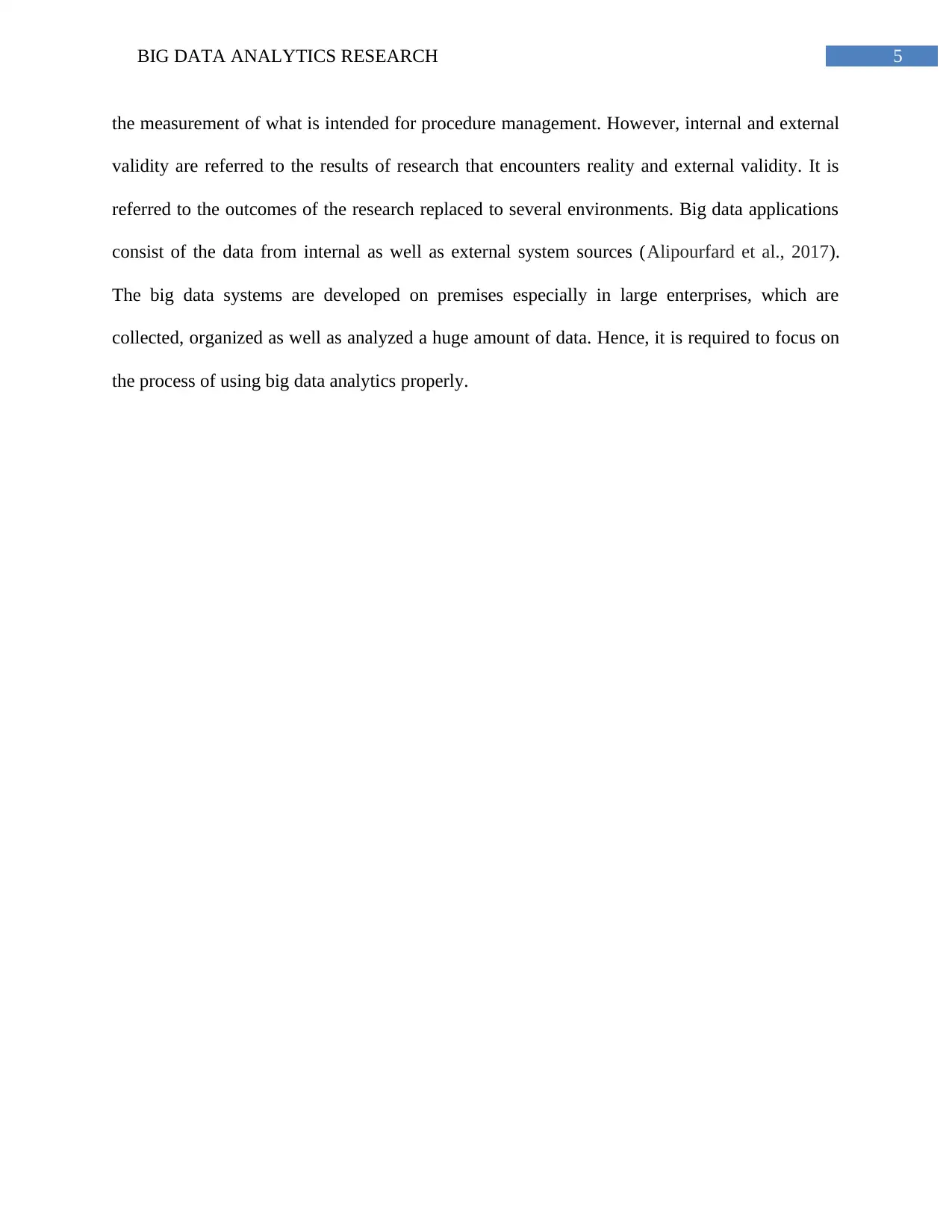
5BIG DATA ANALYTICS RESEARCH
the measurement of what is intended for procedure management. However, internal and external
validity are referred to the results of research that encounters reality and external validity. It is
referred to the outcomes of the research replaced to several environments. Big data applications
consist of the data from internal as well as external system sources (Alipourfard et al., 2017).
The big data systems are developed on premises especially in large enterprises, which are
collected, organized as well as analyzed a huge amount of data. Hence, it is required to focus on
the process of using big data analytics properly.
the measurement of what is intended for procedure management. However, internal and external
validity are referred to the results of research that encounters reality and external validity. It is
referred to the outcomes of the research replaced to several environments. Big data applications
consist of the data from internal as well as external system sources (Alipourfard et al., 2017).
The big data systems are developed on premises especially in large enterprises, which are
collected, organized as well as analyzed a huge amount of data. Hence, it is required to focus on
the process of using big data analytics properly.
⊘ This is a preview!⊘
Do you want full access?
Subscribe today to unlock all pages.

Trusted by 1+ million students worldwide
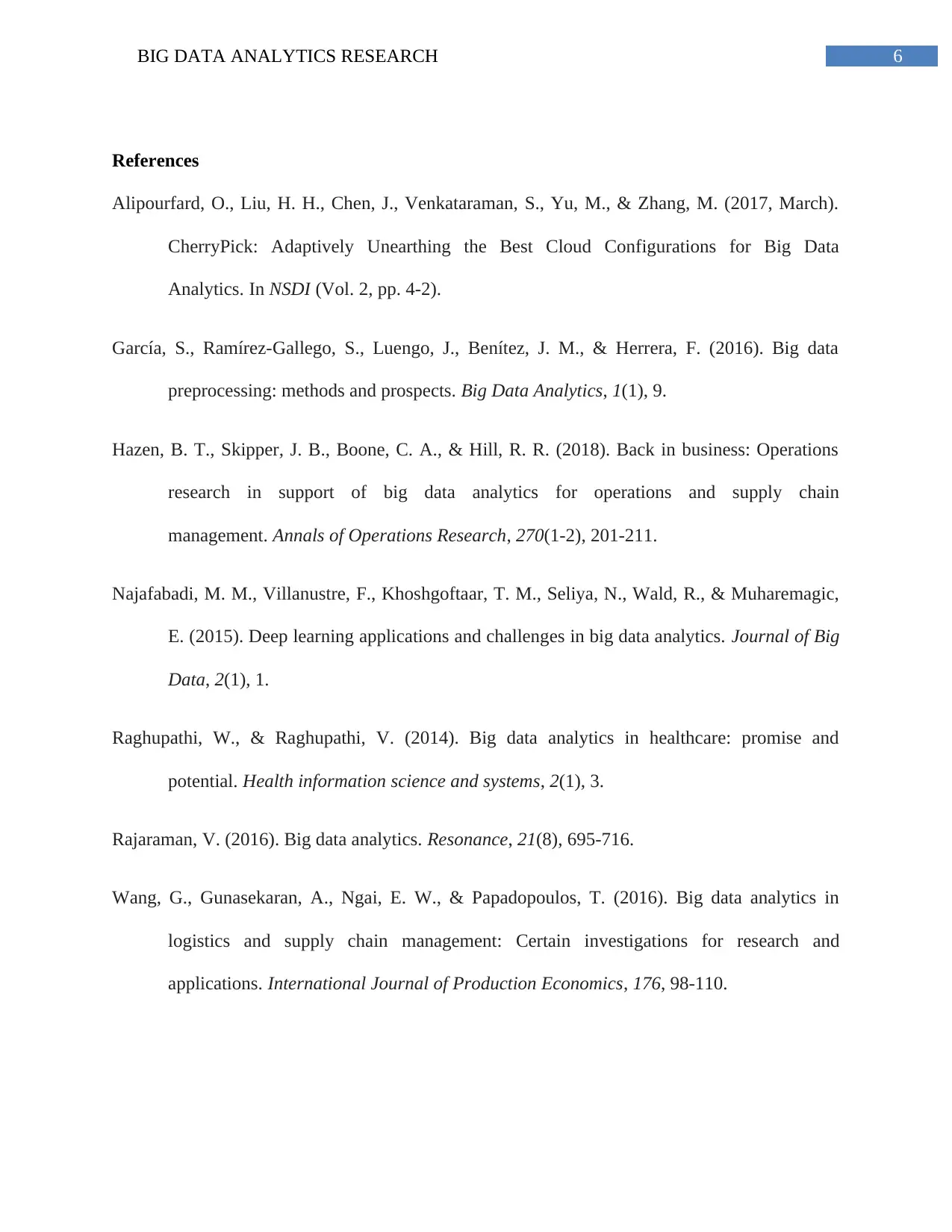
6BIG DATA ANALYTICS RESEARCH
References
Alipourfard, O., Liu, H. H., Chen, J., Venkataraman, S., Yu, M., & Zhang, M. (2017, March).
CherryPick: Adaptively Unearthing the Best Cloud Configurations for Big Data
Analytics. In NSDI (Vol. 2, pp. 4-2).
García, S., Ramírez-Gallego, S., Luengo, J., Benítez, J. M., & Herrera, F. (2016). Big data
preprocessing: methods and prospects. Big Data Analytics, 1(1), 9.
Hazen, B. T., Skipper, J. B., Boone, C. A., & Hill, R. R. (2018). Back in business: Operations
research in support of big data analytics for operations and supply chain
management. Annals of Operations Research, 270(1-2), 201-211.
Najafabadi, M. M., Villanustre, F., Khoshgoftaar, T. M., Seliya, N., Wald, R., & Muharemagic,
E. (2015). Deep learning applications and challenges in big data analytics. Journal of Big
Data, 2(1), 1.
Raghupathi, W., & Raghupathi, V. (2014). Big data analytics in healthcare: promise and
potential. Health information science and systems, 2(1), 3.
Rajaraman, V. (2016). Big data analytics. Resonance, 21(8), 695-716.
Wang, G., Gunasekaran, A., Ngai, E. W., & Papadopoulos, T. (2016). Big data analytics in
logistics and supply chain management: Certain investigations for research and
applications. International Journal of Production Economics, 176, 98-110.
References
Alipourfard, O., Liu, H. H., Chen, J., Venkataraman, S., Yu, M., & Zhang, M. (2017, March).
CherryPick: Adaptively Unearthing the Best Cloud Configurations for Big Data
Analytics. In NSDI (Vol. 2, pp. 4-2).
García, S., Ramírez-Gallego, S., Luengo, J., Benítez, J. M., & Herrera, F. (2016). Big data
preprocessing: methods and prospects. Big Data Analytics, 1(1), 9.
Hazen, B. T., Skipper, J. B., Boone, C. A., & Hill, R. R. (2018). Back in business: Operations
research in support of big data analytics for operations and supply chain
management. Annals of Operations Research, 270(1-2), 201-211.
Najafabadi, M. M., Villanustre, F., Khoshgoftaar, T. M., Seliya, N., Wald, R., & Muharemagic,
E. (2015). Deep learning applications and challenges in big data analytics. Journal of Big
Data, 2(1), 1.
Raghupathi, W., & Raghupathi, V. (2014). Big data analytics in healthcare: promise and
potential. Health information science and systems, 2(1), 3.
Rajaraman, V. (2016). Big data analytics. Resonance, 21(8), 695-716.
Wang, G., Gunasekaran, A., Ngai, E. W., & Papadopoulos, T. (2016). Big data analytics in
logistics and supply chain management: Certain investigations for research and
applications. International Journal of Production Economics, 176, 98-110.
Paraphrase This Document
Need a fresh take? Get an instant paraphrase of this document with our AI Paraphraser
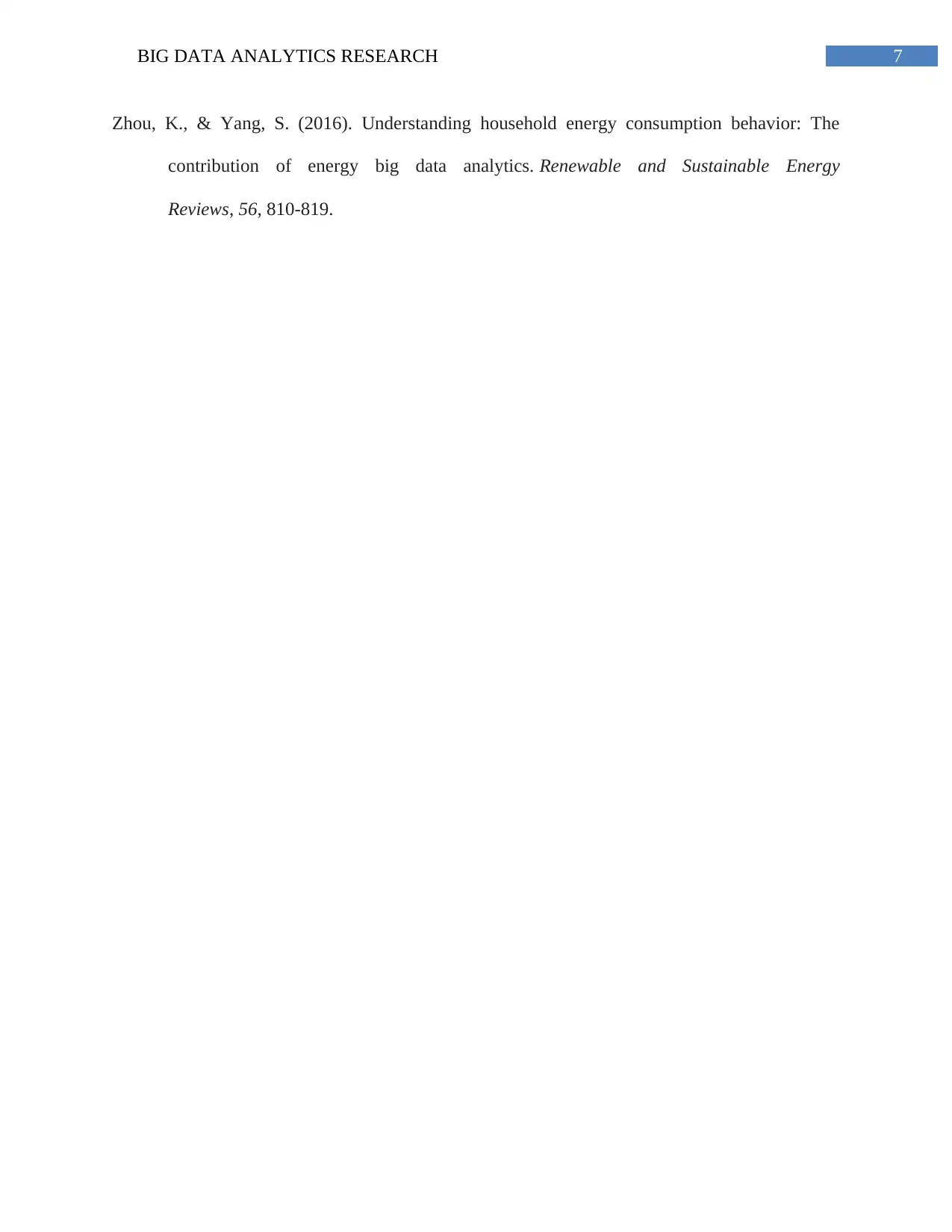
7BIG DATA ANALYTICS RESEARCH
Zhou, K., & Yang, S. (2016). Understanding household energy consumption behavior: The
contribution of energy big data analytics. Renewable and Sustainable Energy
Reviews, 56, 810-819.
Zhou, K., & Yang, S. (2016). Understanding household energy consumption behavior: The
contribution of energy big data analytics. Renewable and Sustainable Energy
Reviews, 56, 810-819.
1 out of 8
Related Documents
Your All-in-One AI-Powered Toolkit for Academic Success.
+13062052269
info@desklib.com
Available 24*7 on WhatsApp / Email
![[object Object]](/_next/static/media/star-bottom.7253800d.svg)
Unlock your academic potential
Copyright © 2020–2025 A2Z Services. All Rights Reserved. Developed and managed by ZUCOL.


